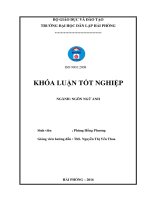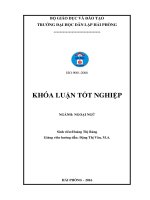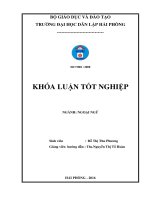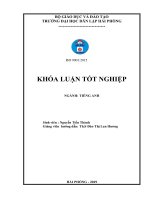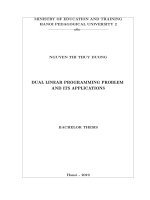Association between rs2069718, rs280500, rs6443624 and rs1042522 variants and risks of essential thrombocythemia (khóa luận tốt nghiệp)
Bạn đang xem bản rút gọn của tài liệu. Xem và tải ngay bản đầy đủ của tài liệu tại đây (830.88 KB, 54 trang )
VIETNAM NATIONAL UNIVERSITY OF AGRICULTURE
FACULTY OF BIOTECHNOLOGY
------- -------
GRADUATION THESIS
TITLE: ASSOCIATION BETWEEN RS2069718,
RS280500, RS6443624 AND RS1042522 VARIANTS
AND RISKS OF ESSENTIAL THROMBOCYTHEMIA
Hanoi, November 2022
VIETNAM NATIONAL UNIVERSITY OF AGRICULTURE
FACULTY OF BIOTECHNOLOGY
------- -------
GRADUATION THESIS
TITLE: ASSOCIATION BETWEEN RS2069718,
RS280500, RS6443624 AND RS1042522 VARIANTS
AND RISKS OF ESSENTIAL THROMBOCYTHEMIA
Student name
: Pham Viet Nhat
Student code
: 634847
Class
: K63CNSHE
Faculty
: Biotechnology
Supervisor
: Assoc. Prof. Nguyen Thi Xuan
McS. Nguyen Thanh Huyen
Hanoi, November 2022
COMMITMENT
The work on this thesis has not been submitted for a degree or diploma at
any other institution of higher education. I hereby declare that the work of this
thesis is my own work. To the best of my knowledge and belief, this thesis
contains no material previously published or written by others unless
referenced.
Hanoi, December 5th, 2022
Student
Pham Viet Nhat
i
ACKNOWLEDGEMENTS
First, I would like to express my gratitude to the director of Vietnam
National University of Agriculture, board of dean and all teachers in Faculty of
Biotechnology gave me possibility to complete this thesis.
I also express my heartfelt respect, gratitude and sincere appreciation to
Assoc. Prof. Nguyen Thi Xuan, Department of Immunogenomic, Institute of
Genome Research (IGR) for constructive criticisms and constant inspiration
during the entire period of the study as well as the research, for your time to
help me in writing and for provide me the opportunity to carry out my thesis in
the laboratory of Institute of Genome Research.
I would like to thank all teachers from Department of Biology, Faculty of
Biotechnology, especially McS. Nguyen Thanh Huyen who encouraged me to
enhance my knowledge and help me get the orientation of thesis.
I also wish to show my appreciation towards all the staff members of the
Immunogenomics Laboratory, who supported me the laboratory techniques and
statistical analysis.
Last but not least, I owe a debt of gratitude to my beloved parents, relatives
and friends for their blessings, constant source of inspiration, all out sacrifice
and moral support throughout the entire period of my academic life.
With warm and regards!
Hanoi, December 5th, 2022
Student
Pham Viet Nhat
ii
CONTENTS
COMMITMENT .................................................................................................... i
ACKNOWLEDGEMENTS .................................................................................. ii
CONTENTS .........................................................................................................iii
LIST OF TABLES ............................................................................................... vi
LIST OF FIGURES ............................................................................................ vii
LIST OF ABBREVIATIONS............................................................................... x
CHAPTER 1: INTRODUCTION ..................................................................... 1
1.1. Preface............................................................................................................ 1
1.2. Objectives and Requirements ........................................................................ 2
1.2.1 Objectives .................................................................................................... 2
1.2.2. Requirements .............................................................................................. 2
CHAPTER 2: LITERATURE REVIEWS ....................................................... 3
2.1. Essential thrombocythemia overview ............................................................ 3
2.1.1. Definition of Essential thrombocythemia ................................................... 3
2.1.2. Epidemiology of Essential thrombocythemia............................................. 3
2.1.3. Etiology and pathophysiologic mechanisms .............................................. 3
2.2. Studies of Essential thrombocythemia in the world and Vietnam ................ 4
2.2.1. Studies of Essential thrombocythemia in the world ................................... 4
2.2.2. Studies of Essential thrombocythemia in Vietnam .................................... 6
2.3. IFNG gene overview ...................................................................................... 6
2.3.1. Definition of IFNG ..................................................................................... 6
2.3.2. The location of IFNG gene ......................................................................... 6
2.3.3. The function of IFNG gene......................................................................... 6
2.4 TYK2 gene overview ...................................................................................... 7
2.4.1. Definition of TYK2 .................................................................................... 7
2.4.2. The location of TYK2 gene ........................................................................ 7
2.4.3. The function of TYK2 gene ........................................................................ 7
iii
2.5. PIK3CA gene overview ................................................................................. 8
2.5.1. Definition of PIK3CA ................................................................................. 8
2.5.2. The location of PIK3CA gene .................................................................... 8
2.5.3. The function of PIK3CA gene .................................................................... 9
2.6. TP53 gene overview ...................................................................................... 9
2.6.1. Definition of TP53 ...................................................................................... 9
1.6.2. The location of TP53 gene ........................................................................ 10
2.6.3. The function of TP53 gene ....................................................................... 10
CHAPTER 3: MATERIALS AND EXPERIMENTAL METHODS .......... 11
3.1. Materials ...................................................................................................... 11
3.1.1. Objects of study ........................................................................................ 11
3.1.2. List of primers ........................................................................................... 11
3.1.3. Chemicals .................................................................................................. 12
3.1.4. Equipment ................................................................................................. 12
3.2. Methods........................................................................................................ 13
3.2.1. Genomic DNA extraction ......................................................................... 13
3.2.2. PCR ........................................................................................................... 14
3.2.3. SNP genotyping ........................................................................................ 15
3.2.4. Analysis of gene polymorphisms/mutations ............................................. 18
3.2.5. Statistical analysis ..................................................................................... 18
CHAPTER 4: RESULTS AND DISCUSSION .............................................. 21
4.1. DNA extraction ............................................................................................ 21
4.2. Association between IFNG gene rs2069718 variants and risk of essential
thrombocythemia....................................................................................... 21
4.2.1. Results of gene polymorphism analysis ................................................... 21
4.2.2. Sequence analysis of some samples by sequencing method .................... 23
4.3. Association between TYK2 gene rs280500 variants and risk of essential
thrombocythemia....................................................................................... 26
iv
4.3.1. Results of gene polymorphism analysis ................................................... 26
4.3.2. Sequence analysis of some samples by sequencing method .................... 27
4.4. Association between PI3KCA gene rs6443624 variants and risk of
essential thrombocythemia ........................................................................ 30
4.4.1. Results of gene polymorphism analysis ................................................... 30
4.4.2. Sequence analysis of some samples by sequencing method .................... 31
4.5. Association between TP53 gene rs1042522 variants and risk of essential
thrombocythemia....................................................................................... 34
4.5.1. Results of gene polymorphism analysis ................................................... 34
4.5.2. Sequence analysis of some samples by sequencing method .................... 35
4.5. Discussion .................................................................................................... 38
CHAPTER 5: CONCLUSION AND SUGGESTION ................................... 39
5.1. Conclusion ................................................................................................... 39
5.2. Suggestion .................................................................................................... 40
REFERENCES .................................................................................................. 41
v
LIST OF TABLES
Table 3.1: Primers used for amplification .......................................................... 11
Table 3.2: List of laboratoty equipment............................................................. 12
Table 3.3: Components of PCR reaction ........................................................... 14
Table 3.4: Constituent reagent volumes for KASP genotyping reaction of wet
DNA method for 384-well plate ....................................................... 16
Table 4.1: Distributions of genotypes of the IFNG gene rs2069718 between
essential thrombocythemia and control groups ................................ 22
Table 4.2: Distributions of genotypes of the TYK2 gene rs280500 between
essential thrombocythemia and control groups ................................ 26
Table 4.3: Distributions of genotypes of the PL3KCA gene rs6443624 between
essential thrombocythemia and control groups ................................ 30
Table 4.4: Distributions of genotypes of the TP53 gene rs1042522 between
essential thrombocythemia and control groups ................................ 34
vi
LIST OF FIGURES
Figure 1.1: Late excess mortality in essential thrombocythemia: a
population-based study in the Netherlands, 2001–2018 .................... 5
Figure 1.2: IFNG Gene in genomic location: bands according to Ensembl,
locations according to GeneLoc ......................................................... 6
Figure 1.3: TYK2 Gene in genomic location: bands according to Ensembl,
locations according to GeneLoc ......................................................... 7
Figure 1.4: PIK3CA Gene in genomic location: bands according to
Ensembl, locations according to GeneLoc ......................................... 8
Figure 1.5: TP53 Gene in genomic location: bands according to Ensembl,
locations according to GeneLoc ....................................................... 10
Figure 3.1: PCR amplification heat cycle .......................................................... 14
Figure 3.2: SNP Genotyping – KASP system. .................................................. 15
Figure 3.3: Thermal cycle conditions for KASP genotyping reactions. ........... 16
Figure 4.1: Agarose gel electrophoresis of genomic DNA. A. 1-2: Total
DNA of essential thrombocythemia patients, 3- 5: Total DNA of
control subjects. ................................................................................ 21
Figure 4.2: Analytical results SNP genotyping, orange dots: wild type
genotypes, green dots: heterozygous genotypes, blue dots
homozygous genotypes A: Patients group B: Controls group ......... 22
Figure 4.3: Agarose gel electrophoresis of PCR product of IFNG gene. A.
1-2: PCR product of essential thrombocythemia patients, 3-5:
PCR product of control subjects. ...................................................... 24
Figure 4.4: Result of the nucleotide sequence of representative individual
carrying GG genotype of IFNG gene rs2069718 polymorphism ..... 25
Figure 4.5: Result of the nucleotide sequence of representative individual
carrying AG genotype of IFNG gene rs2069718 polymorphism. .... 25
vii
Figure 4.6: Result of the nucleotide sequence of representative individual
carrying AA genotype of IFNG gene rs2069718 polymorphism. .... 25
Figure 4.7: Agarose gel electrophoresis of PCR product of TYK2 gene. 1-2:
PCR product of essential thrombocythemia patients, 3-4: PCR
product of control subjects. .............................................................. 28
Figure 4.8: Result of the nucleotide sequence of representative individual
carrying GG genotype of TYK2 gene rs280500 polymorphism ...... 29
Figure 4.9: Result of the nucleotide sequence of representative individual
carrying AG genotype of TYK2 gene rs280500 polymorphism. ..... 29
Figure 4.10: Result of the nucleotide sequence of representative individual
carrying AA genotype of TYK2 gene rs280500 polymorphism. ..... 29
Figure 4.11: Agarose gel electrophoresis of PCR product of PL3KCA gene.
1-3: PCR product of essential thrombocythemia patients, 4-7:
PCR product of control subjects. ...................................................... 32
Figure 4.12: Result of the nucleotide sequence of representative individual
carrying
AA
genotype
of
PL3KCA
gene
rs6443624
polymorphism ................................................................................... 33
Figure 4.13: Result of the nucleotide sequence of representative individual
carrying
CA
genotype
of
PL3KCA
gene
rs6443624
polymorphism. .................................................................................. 33
Figure 4.14: Result of the nucleotide sequence of representative individual
carrying
CC
genotype
of
PL3KCA
gene
rs6443624
polymorphism. .................................................................................. 33
Figure 4.15: Agarose gel electrophoresis of PCR product of TP53 gene. 12: PCR product of essential thrombocythemia patients, 3-4: PCR
product of control subjects. .............................................................. 36
Figure 4.16: Result of the nucleotide sequence of representative individual
carrying CC genotype of TP53 gene rs1042522 polymorphism ...... 37
viii
Figure 4.17: Result of the nucleotide sequence of representative individual
carrying TG genotype of TP53 gene rs1042522 polymorphism. ..... 37
Figure 4.18: Result of the nucleotide sequence of representative individual
carrying GG genotype of TP53 gene rs1042522 polymorphism ..... 37
ix
LIST OF ABBREVIATIONS
Bp
: Base pair
ddNTPs
: Dideoxynucleotides
DNA
: Deoxyribonucleic Acid
dNTPs
: Deoxyribonucleotide triphosphates
EDTA
: Ethylenediaminetetraacetic acid
TAE
: Tris-acetate-EDTA
EtBr
: Ethidium bromide
rpm
: Round per minute
EtOH
: Etanol
OR
: Odds ration
CI
: Confidence Interval
SNPs
: Single Nucleotide Polymorphisms
IFNG
: Interferon gamma
TYK2
: Tyrosine kinase 2
PI3KCA
: Phosphatidylinositol 3-kinase
TP53
: Tumor protein p53
PCR
: Polymerase Chain Reaction
KASP
: Kompetitive Allele Specific PCR
x
xi
CHAPTER 1: INTRODUCTION
1.1. Preface
Today's society develops spiritual and material life of people is enhanced.
However, there are still diseases that prevent people from enjoying this
beautiful life. One of them is cancer. And this article we study about primary
thrombocythemia, which is a type of medullary proliferative cancer.
Blood is extremely important to the human body. Blood is a mobile organ in
the body that exists as a liquid tissue, circulating throughout the body through
arteries and veins. Blood is the organizational component of the body, it
circulates in the arteries, veins and capillaries and performs many important
physiological functions. The role of the plasma is to carry nutrients to the
tissues and carry waste products from the tissues to the organs for excretion. In
addition, the roles of blood cells include secretion, protection, regulation and
nutrition.
In which platelets also play an extremely important role:
− Platelets are very small pieces of cells that help stop bleeding by forming
blood clots that seal wounds in the blood vessel walls. If a blood vessel is
damaged (for example cut or bruised), the platelets will gather at this
point and stick to each other, forming an 'opening plug'.
− Deficiency of platelets, can cause people to often have nosebleeds, when
cut, the bleeding will stop, abnormal bruising, or bowel movements,
blood in the urine, bleeding skin.
− In severe cases, when the platelet count is too low, internal organs and
brain can bleed. Your medical team will let you know when your platelet
count drops.
1
− In addition, platelets also play a role in making blood vessel walls soft
and supple thanks to the function of platelets to "rejuvenate" endothelial
cells. The life cycle of platelets is about 7-10 days. Just like red blood
cells. and white blood cells, bone marrow is where platelets are produced.
However, when platelets proliferate too much, it is not good for health.
Currently,
there
are
2
types:
essential
thrombocythemia,
essential
thrombocytosis. The cause of essential thrombocytosis is acute infection,
chronic inflammatory disorders, bleeding, ... While essential thrombocythemia
is harder to know, causing the faulty bone marrow to produce too much platelet.
1.2. Objectives and Requirements
1.2.1 Objectives
Therefore, the aim of the study: “Association between rs2069718, rs280500,
rs6443624 and rs1042522 variants and risks of essential thrombocythemia” is to
explore new SNPs on the IFNG, TYK2, PI3KCA, TP53 gene promoter
fragment of Vietnamese essential thrombocythemia patients as well as
investigate these SNPs frequency. Furthermore, whether there is a link between
these SNPs and essential thrombocythemia disease or not. From this research it
is possible to develop new treatments for patients with unexplained essential
thrombocythemia diseases.
1.2.2. Requirements
In order to achieve the objective of the study, several requirements need to
be completed.
− Collecting samples and extracting DNA from samples.
− Amplifying and sequencing the IFNG, TYK2, PI3KCA, TP53 gene
− Detecting SNPs in the sequences and identifying its frequency
− Analyzing collected data
2
CHAPTER 2: LITERATURE REVIEWS
2.1. Essential thrombocythemia overview
2.1.1. Definition of Essential thrombocythemia
Essential thrombocythemia or primary thrombocythemia (pronounced
thräm-bō-sī-thē-mē-ə) is a rare blood disorder that happens when abnormal stem
cells in your bone marrow make too many platelets. Platelets are blood cells that
slow or stop bleeding by creating blood clots. Essential thrombocythemia is an
acquired genetic condition, meaning it happens when certain genes mutate or
change.
You may learn you have this condition when a routine blood test shows
your platelet levels are unusually high. You may not have symptoms and you
may not need immediate treatment. Essential thrombocythemia is not curable
but treatment may reduce the risk you’ll develop serious complications [1].
2.1.2. Epidemiology of Essential thrombocythemia
Essential thrombocytosis is the most common type of myeloproliferative
neoplasm. Reports are that 1.0 to 2.5 individuals per 100000 have essential
thrombocytosis yearly (Meier B and Burton JH, 2017). The prevalence was
reported to be 38 to 57 per 100000 between 2008 and 2010 and mostly
occurring in females (Mehta J et al. 2014). The incidence of essential
thrombocytosis increases with age, with most patients presenting between the
ages of 50 and 60.
2.1.3. Etiology and pathophysiologic mechanisms
The primary cause of essential thrombocythemia is the overproduction of
hematopoietic cells due to the mutation of JAK2, CALR or MPL gene. These
genes are known as driver mutations due to the role they play in the
3
development of a myeloproliferative neoplasm (Nangalia J and Green AR,
2017).
The driver genes JAK2, CALR, and MPL, have specific functions which
when mutated cause myeloproliferative effects. In 2005, research showed that a
single point mutation of the JAK2 leads to a myeloproliferative neoplasm
(Kralovics R et al. 2005). The point mutation causes a change in the amino acid
from valine to phenylalanine at codon 617, hence, the abbreviation JAK2V617F
(Falchi L et al. 2017). JAK 2 is a non-receptor tyrosine kinase found in the
cytoplasm playing a pivotal role in hematopoiesis. Its mutation aids in the gain
of function leading to the activation of intracellular signaling pathways
associated with the receptors of hematopoietic cytokines: erythropoietin,
thrombopoietin, and granulocyte colony-stimulating factor (Nangalia J and
Green AR, 2017). About half of patients with essential thrombocytosis have
JAK2 mutation (Nangalia J and Green AR, 2017). CALR mutation occurs due
to insertions or deletions causing a shift in the amino acid reading frame which
leads to the formation of a novel C terminus (Nangalia J and Green AR, 2017).
CALR is normally involved in cellular proliferation, differentiation, and
apoptosis (Nangalia J and Green AR, 2017). MPL gene, on the other hand, is
reported to be mutated via point mutation and about 3 to 15% of essential
thrombocytosis patients are affected by this mutation (Falchi L et al. 2017).
2.2. Studies of Essential thrombocythemia in the world and Vietnam
2.2.1. Studies of Essential thrombocythemia in the world
Essential thrombocytosis is also known as essential thrombocythemia (ET).
It was first recognized in 1934; however, at that time, it was described as
hemorrhagic thrombocythemia. Essential thrombocytosis is one of the
myeloproliferative neoplasms. It was classified as a myeloproliferative
4
neoplasm in 1951 by Damesheck (Cervantes F, 2011). Myeloproliferative
neoplasm includes polycythemia vera, primary myelofibrosis, and essential
polycythemia (Barbui T et al. 2016). The three types of myeloproliferative
neoplasm are similar as they share the same mutations. Approximately 55% of
patients with essential thrombocytosis have the JAK2 mutation (Tefferi A and
Pardanani
A,
2015).
Essential
thrombocytosis
is
characterized
by
thrombocytosis with the presence of megakaryocytic hyperplasia in the bone
marrow. Due to thrombocytosis, there are risks of vascular events such as
thrombosis and hemorrhage and sometimes the conversion to a blast phase of
myelofibrosis. (Michiels JJ et al. 1999) According to the World Health
Organization, essential thrombocytosis is a disease that occurs when the platelet
count is more than 450000 with the presence of Janus kinase 2 (JAK2),
Calreticulin (CALR) or myeloproliferative leukemia virus oncogene (MPL)
mutation, lacking clonal or reactive causes (Tefferi A et al. 2018).
Figure 1.1: Late excess mortality in essential thrombocythemia: a
population-based study in the Netherlands, 2001–2018
5
2.2.2. Studies of Essential thrombocythemia in Vietnam
In the Vietnam, doctors often treat aspirin 81mg once a day for mild
vascular symptoms (e.g. headache, ischemia, erythema) and to reduce the risk
of thrombosis in patients with whose patients Risk or if needed, use higher
doses. If severe migraines can use platelet lowering. The use of aspirin during
pregnancy has not been proven and can cause bleeding in patients with platelets
mutant CALR.
2.3. IFNG gene overview
2.3.1. Definition of IFNG
Interferon gamma (IFNG) is a cytokine critical to both innate and adaptive
immunity, and functions as the primary activator of macrophages, in addition to
stimulating natural killer cells and neutrophils.
2.3.2. The location of IFNG gene
Figure 1.2: IFNG Gene in genomic location: bands according to Ensembl,
locations according to GeneLoc
2.3.3. The function of IFNG gene
IFNG, or type II interferon, is a cytokine that is critical for innate and
adaptive immunity against viral, some bacterial and protozoan infections. IFNG
is
an
important
activator
of
macrophages
and
inducer
of
major
histocompatibility complex class II molecule expression. Aberrant IFNG
expression is associated with a number of autoinflammatory and autoimmune
diseases. The importance of IFNG in the immune system stems in part from its
6
ability to inhibit viral replication directly, and most importantly from its
immunostimulatory and immunomodulatory effects. IFNG is produced
predominantly by natural killer cells (NK) and natural killer T cells (NKT) as
part of the innate immune response, and by CD4 Th1 and CD8 cytotoxic T
lymphocyte (CTL) effector T cells once antigen-specific immunity develops
(Schoenborn JR and Wilson CB, 2007) as part of the adaptive immune
response. IFNG is also produced by non-cytotoxic innate lymphoid cells (ILC),
a family of immune cells first discovered in the early 2010s (Artis D and Spits
H, 2015).
2.4 TYK2 gene overview
2.4.1. Definition of TYK2
Tyrosine kinase 2 (TYK2) encodes a member of the tyrosine kinase and,
more specifically, the Janus kinases (JAKs) protein families. This protein
associates with the cytoplasmic domain of type I and type II cytokine receptors
and promulgate cytokine signals by phosphorylating receptor subunits (Han S
… Kang D, 2010).
2.4.2. The location of TYK2 gene
Figure 1.3: TYK2 Gene in genomic location: bands according to Ensembl,
locations according to GeneLoc
2.4.3. The function of TYK2 gene
This gene encodes a member of the tyrosine kinase and, to be more specific,
the Janus kinases (JAKs) protein families. This protein associates with the
7
cytoplasmic domain of type I and type II cytokine receptors and promulgate
cytokine signals by phosphorylating receptor subunits. It is also component of
both the type I and type III interferon signaling pathways. As such, it may play
a role in anti-viral immunity.
Cytokines play pivotal roles in immunity and inflammation by regulating the
survival, proliferation, differentiation, and function of immune cells, as well as
cells from other organ systems (Nicola and Nicos, 1994). Hence, targeting
cytokines and their receptors is an effective means of treating such disorders.
Type I and II cytokine receptors associate with Janus family kinases (JAKs) to
affect intracellular signaling. Cytokines including interleukins, interferons and
hemopoietins activate the Janus kinases, which associate with their cognate
receptors (Kubo M et al. 2003).
2.5. PIK3CA gene overview
2.5.1. Definition of PIK3CA
Phosphatidylinositol 3-kinase is composed of an 85 kDa regulatory subunit
and a 110 kDa catalytic subunit. The protein encoded by this gene represents the
catalytic subunit, which uses ATP to phosphorylate PtdIns, PtdIns4P and
PtdIns(4,5)P2 (Prenen H … Tejpar S, 2009).
2.5.2. The location of PIK3CA gene
Figure 1.4: PIK3CA Gene in genomic location: bands according to
Ensembl, locations according to GeneLoc
8
2.5.3. The function of PIK3CA gene
The PIK3CA gene provides instructions for making the p110 alpha (p110α)
protein, which is one piece (subunit) of an enzyme called phosphatidylinositol
3-kinase (PI3K).
Participates in cellular signaling in response to various growth factors.
Involved in the activation of AKT1 upon stimulation by receptor tyrosine
kinases ligands such as EGF, insulin, IGF1, VEGFA and PDGF. Involved in
signaling via insulin-receptor substrate (IRS) proteins. Essential in endothelial
cell migration during vascular development through VEGFA signaling, possibly
by regulating RhoA activity. Required for lymphatic vasculature development,
possibly by binding to RAS and by activation by EGF and FGF2, but not by
PDGF. Regulates invadopodia formation through the PDPK1-AKT1 pathway.
Participates in cardiomyogenesis in embryonic stem cells through a AKT1
pathway. Participates in vasculogenesis in embryonic stem cells through PDK1
and protein kinase C pathway. In addition to its lipid kinase activity, it displays
a serine-protein kinase activity that results in the autophosphorylation of the
p85alpha regulatory subunit as well as phosphorylation of other proteins such as
4E 1, H-Ras, the IL-3 beta c receptor and possibly others [18].
2.6. TP53 gene overview
2.6.1. Definition of TP53
This gene encodes a tumor suppressor protein containing transcriptional
activation, DNA binding, and oligomerization domains. The encoded protein
responds to diverse cellular stresses to regulate expression of target genes,
thereby inducing cell cycle arrest, apoptosis, senescence, DNA repair, or
changes in metabolism [19].
9
1.6.2. The location of TP53 gene
Figure 1.5: TP53 Gene in genomic location: bands according to Ensembl,
locations according to GeneLoc
2.6.3. The function of TP53 gene
Tp53 plays a role in regulation or progression through the cell cycle,
apoptosis, and genomic stability. Levels of TP53 play an important role in the
maintenance of stem cells throughout development and the rest of human life.
Apart from the cellular and molecular effects above, TP53 has a tissue-level
anticancer effect that works by inhibiting angiogenesis [20].
10
CHAPTER 3: MATERIALS AND EXPERIMENTAL METHODS
3.1. Materials
3.1.1. Objects of study
This study was conducted and approved by the Ethical Committee of
Institute of Genome Research, Vietnam Academy of Science and Technology,
Hanoi, Vietnam.
All the blood samples were from the National Institute of Hematology and
Blood Transfusion and Vietnam Military Medical University, Ha Noi, Vietnam
stored in EDTA tubes and transported to the laboratory on the same day,
preserved at -20oC after DNA extraction. There are two groups of samples:
i) Patients with essential thrombocythemia disease (n=106), 103 for IFNG,102
for TYK2, 85 for PI3KCA, 97 for TP53
ii) control group with no essential thrombocythemia disorder (n=150), 113 for
IFNG, 117 for TYK2, 107 for PI3KCA, 128 for TP53.
We collected blood samples of study participants after obtaining informed
consent from subjects.
3.1.2. List of primers
The primer pair for replication of the TNF-α promoter fragment was
designed based on the reference sequence published in GenBank
Table 3.1: Primers used for amplification
Primers
Sequence (5’ – 3’)
IFNG-F
5’- ACACCAAATCCAAAACGAGTGAA -3’
IFNG-R
5’- CTGTAATCCCCCAGCCATCC -3’
TYK2-F
5’- ACAGGCAGATGTGGTCAAACA-3’
TYK2-R
5’- TCCTAGGCTTTGGGGAGTCA -3’
PI3KCA-F
5’- TGTCAGTTCTCCCTGTTCTCA -3’
11
Primers
Sequence (5’ – 3’)
PI3KCA-R
5’- AGACAAGAGGCCCTGAAAGC -3’
TP53-F
5’- AAGTCTCATGGAAGCCAGCC -3’
TP53-R
5’- GTGGATCCATTGGAAGGGCA -3’
3.1.3. Chemicals
The chemicals used in experiments were:
− PCR: MgCl2, Taq DNA polymerase and dNTP (Fermentas)
− Electrophoresis: Agarose, DNA lader and marker, 6X Loading Dye,
Ethidium Bromide (IDT and Enzymnomics)
− DNA purification: PCR-product (Bioneer, Qiagen).
− BigDye® Terminator v3.1/ Sequencing Standard Kitfrom ABI.
− Other chemicals such as deionized water, ethanol, acetic acid, EDTA,
Tris HCl, ... from Thermo, Merck, Sigma.
3.1.4. Equipment
Table 3.2: List of laboratoty equipment
No.
Equipments
Origin
1
Refrigerator -20˚C, -84˚C
Sanyo, Japan
2
Pepette
Gilson, United States
3
Analytical Balances
Mettler Toledo, Switzerland
4
pH meter
Mettler Toledo, Switzerland
5
Centrifuge
Eppendorf, Germany
6
Electrophoresis machine
Bio-rad, United States
8
The UV camera GelDoc
Amersham BioSciences
9
GeneAmp PCR System 9700
Thermofisher Scientific, United States
10
ABI PRISM Genetic
Thermofisher Scientific, United States
Analyzer
12


